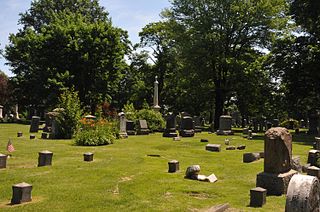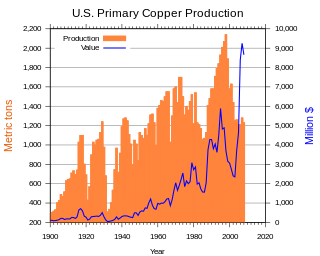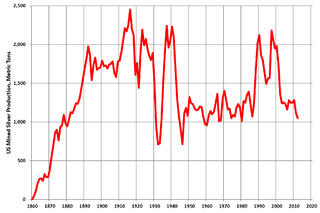Since Alaska became a U.S. state in 1959, it has sent congressional delegations to the United States Senate and United States House of Representatives. Each state elects two senators to serve for six years, and member(s) of the House to two-year terms. Before becoming a state, the Territory of Alaska elected a non-voting delegate at-large to Congress from 1906 to 1959.

Butte is a consolidated city-county and the county seat of Silver Bow County, Montana, United States. In 1977, the city and county governments consolidated to form the sole entity of Butte-Silver Bow. The city covers 718 square miles (1,860 km2), and, according to the 2020 census, has a population of 34,494, making it Montana's fifth-largest city. It is served by Bert Mooney Airport with airport code BTM.

The Copper Country is an area in the Upper Peninsula of Michigan in the United States, including Keweenaw County, Michigan, Houghton, Baraga and Ontonagon counties as well as part of Marquette County. The area is so named as copper mining was prevalent there from 1845 until the late 1960s, with one mine continuing through 1995. In its heyday in the latter half of the 19th century and the early 20th century, the area was the world's greatest producer of copper.

William Sulzer was an American lawyer and politician, nicknamed Plain Bill Sulzer. He was the 39th governor of New York and a long-serving U.S. representative from the same state.

James Wickersham was a district judge for Alaska, appointed by U.S. President William McKinley to the Third Judicial District in 1900. He resigned his post in 1908 and was subsequently elected as Alaska's delegate to Congress, serving until 1917 and then being re-elected in 1930. He was instrumental in the passage of the Organic Act of 1912, which granting Alaska territorial status. He also introduced the Alaska Railroad Bill, legislation to establish McKinley Park, and the first Alaska Statehood Bill in 1916. He was among those responsible for the creation of the Alaska Agricultural College and School of Mines, which later became the University of Alaska. A residence hall on the University of Alaska Fairbanks campus is named in his honor.

William Andrews Clark Sr. was an American entrepreneur, involved with mining, banking, and railroads, as well as a politician.

Evergreen Cemetery and Crematory is a cemetery and crematorium located at 1137 North Broad Street, Hillside, Union County, New Jersey. Parts of it are in Hillside, Elizabeth, and Newark.

Charles August Sulzer was a delegate to the United States House of Representatives from the Territory of Alaska from 1917 to 1919.

George Barnes Grigsby was a delegate to the United States House of Representatives from the Territory of Alaska.

Ruth is a census-designated place (CDP) in White Pine County, Nevada, United States. Founded in 1903, it had a population of 440 at the 2010 census.

Daniel Cowan Jackling , was an American mining and metallurgical engineer who pioneered the exploitation of low-grade porphyry copper ores at the Bingham Canyon Mine, Utah.

In the United States, copper mining has been a major industry since the rise of the northern Michigan copper district in the 1840s. In 2017, the US produced 1.27 million metric tonnes of copper, worth $8 billion, making it the world's fourth largest copper producer, after Chile, China, and Peru. Copper was produced from 23 mines in the US. Top copper producing states in 2014 were Arizona, Utah, New Mexico, Nevada, and Montana. Minor production also came from Idaho, and Missouri. As of 2014, the US had 45 million tonnes of known remaining reserves of copper, the fifth largest known copper reserves in the world, after Chile, Australia, Peru, and Mexico.

Silver mining in the United States began on a major scale with the discovery of the Comstock Lode in Nevada in 1858. The industry suffered greatly from the demonetization of silver in 1873 by the Coinage Act of 1873, known pejoratively as the "Crime of 73", but silver mining continues today.

Cordova Bay is a bay in the Alexander Archipelago of southeast Alaska. It opens onto Dixon Entrance to the south, between Cape Muzon on Dall Island and Point Marsh. The name Puerto Cordova y Cordova was given by the Spanish explorer Lieutenant Don Jacinto Caamaño in 1792, in honor of Admiral Luis de Córdova y Córdova. The name was published by George Vancouver in 1798.
The Alaska-Gastineau Mining Co. had its offices in 25 Broad St., New York City, New York. It was the operating company for the Alaska Gold Mines Co. in Alaska. It worked the Alaska-Gastineau Mine/Perseverance Mine in the Silver Bow Basin, approximately 4 miles (6.4 km) from Juneau and processed its ore at an old remodeled mill and crushing plant at Sheep Creek. The property of the Alaska Juneau Gold Mining Co. adjoined the Alaska Gastineau on the west.
Christmas is an uninhabited mining community in Gila County, Arizona, United States. The mine which led to creation of the town was staked on Christmas Day 1902, prompting the name. During the three decades in which the town's post office operated it was a popular destination for holiday mail seeking a "Christmas" postmark. The mine is also the location where the minerals apachite, junitoite, and ruizite were first discovered.

William Henry Bay is a waterway in the U.S. state of Alaska. It is located near Haines in the Alexander Archipelago. The only commercial copper deposit in Southeast Alaska situated north of Prince of Wales Island was located in the bay. Significant gold and strategic mineral anomalies were found at William Henry Bay during surveys in 2011.

Archibald Everett Spriggs was an American politician and businessman. Affiliated with the People's Party, he served as the lieutenant governor of Montana from 1897 to 1901. After his political career, he embarked on a business career, mostly in the mining industry in Montana.

Oliver Perry Hubbard was a Progressive member of the Alaska Senate from 1915 to 1919. He represented the 3rd district and served as President of the Alaska Senate during the 3rd Territorial Legislature.
















